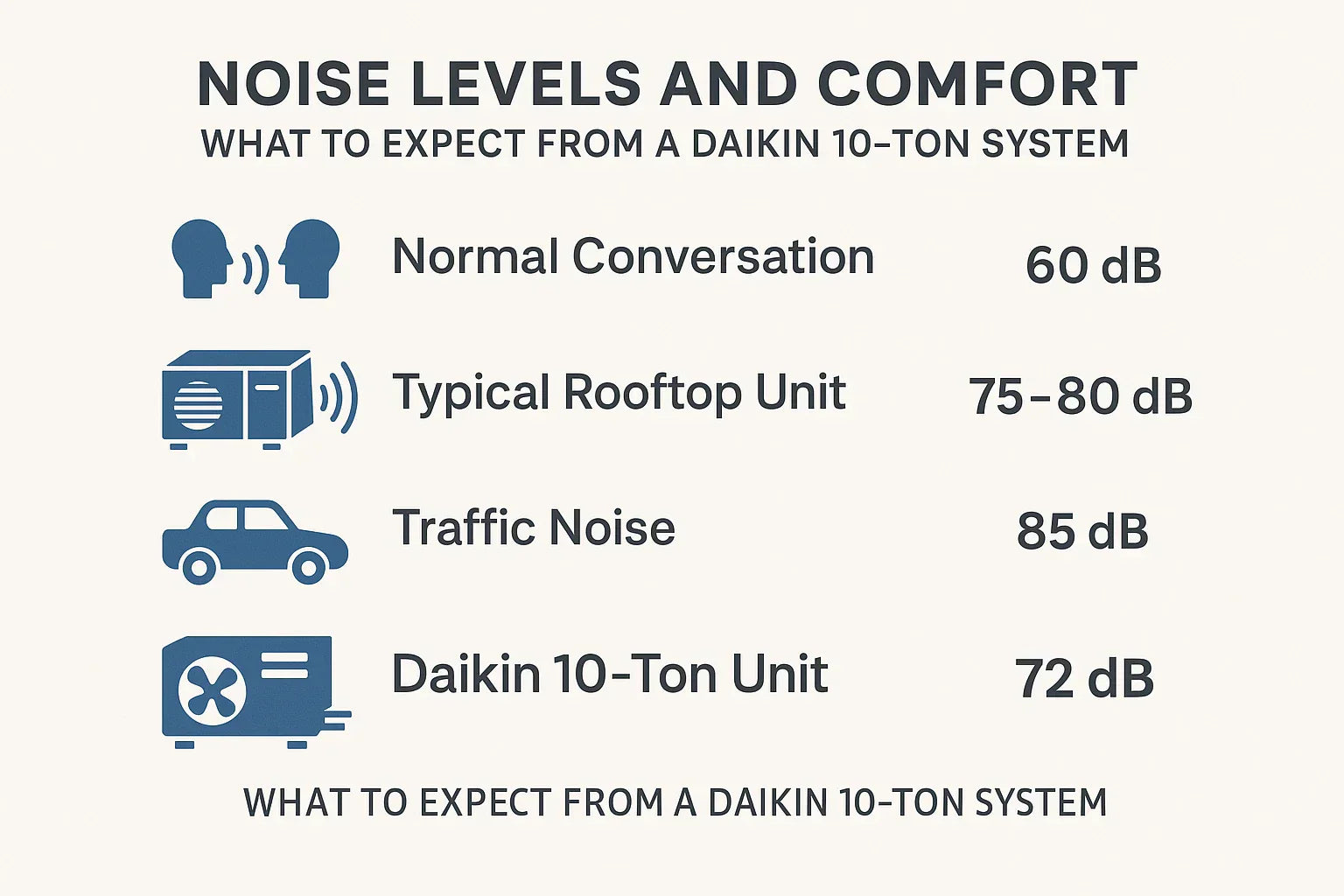When evaluating commercial HVAC systems, most business owners focus on price, efficiency, and capacity. But there’s another factor that directly affects your bottom line: noise and comfort.
Daikin 10 Ton 208/230-3-60V 15 IEER2 Light Commercial Packaged Air Conditioner - DFC1203D000001S
If your employees can’t concentrate because the rooftop unit roars like a truck, or if customers can’t enjoy a quiet conversation in your restaurant, you’re losing productivity, satisfaction, and—ultimately—profits.
Daikin’s 10-ton packaged rooftop AC systems are engineered to address this problem. They don’t just cool efficiently; they deliver a balance of quiet operation, consistent comfort, and smart controls.
In this in-depth guide, we’ll cover:
-
✅ How HVAC noise is measured and why it matters
-
✅ Typical decibel (dB) ranges for commercial packaged systems
-
✅ Daikin’s specific noise-reduction design features
-
✅ How comfort goes beyond temperature to affect humidity, acoustics, and productivity
-
✅ Practical steps to reduce HVAC noise in your building
-
✅ ROI: how comfort and quiet operation directly impact profits and tenant retention
📦 1. Understanding HVAC Noise Levels
Before diving into Daikin’s design, it’s helpful to understand what HVAC noise is—and how it’s measured.
🔎 How Noise is Measured
-
Noise is measured in decibels (dB) on a logarithmic scale.
-
Every increase of 10 dB = roughly doubling of perceived loudness.
-
Example: 70 dB is twice as loud as 60 dB to the human ear.
📊 Typical HVAC Noise Ranges
-
Residential split AC: 50–60 dB (similar to a conversation).
-
Commercial rooftop packaged unit: 70–85 dB at full load.
-
Older, poorly maintained units: 85–95 dB (comparable to city traffic or a lawnmower).
👉 Noise above 70 dB in workplaces has been shown to cause stress, distraction, and reduced productivity.
📖 Reference: OSHA – Noise Guidelines
🎧 2. Daikin’s Noise-Reducing Design
Daikin invests heavily in engineering for quieter commercial systems. While no 10-ton unit will ever be “silent,” the difference between 82 dB and 76 dB can be dramatic in perceived comfort.
Key Design Features:
-
Variable-Speed Fans
-
Fans run slower at partial load, cutting noise by 3–5 dB.
-
Reduced cycling also smooths sound rather than producing loud bursts.
-
-
Insulated Compressor Compartments
-
Vibration dampening reduces mechanical hum.
-
Keeps noise from radiating into the ductwork.
-
-
Aerodynamic Fan Blades
-
Designed to move air more smoothly.
-
Eliminates “chopping” sound common in older designs.
-
-
Advanced Controls
-
Smarter staging = fewer sudden fan/comp kicks.
-
Consistent operation = reduced “startup roar.”
-
👉 Daikin’s 10-ton packaged units often operate 3–5 dB quieter than competitor models or legacy RTUs of similar size.
📖 Reference: Daikin Applied – Rooftop Packaged Units
🛋️ 3. Comfort Beyond Temperature
Most people think of comfort as temperature setpoint. But ASHRAE defines comfort as the combined effect of:
-
🌡️ Temperature stability (avoiding hot/cold swings)
-
💧 Humidity control (keeping indoor relative humidity between 40–60%)
-
🔊 Acoustic comfort (low background noise)
How Daikin Addresses Comfort:
-
Variable compressors maintain steady temps → no drafts or sudden chills.
-
Better humidity control = reduced mold risk and better air quality.
-
Lower noise levels create an environment where employees can focus and customers can relax.
📖 Reference: ASHRAE – Thermal Comfort Standards
📊 4. The ROI of Quiet & Comfortable Systems
Noise and comfort aren’t just “nice-to-have.” They directly impact your bottom line.
💼 Employee Productivity
-
Studies show workplace noise above 70 dB reduces concentration, increases stress, and lowers accuracy.
-
Quieter HVAC → fewer complaints → more productive work environment.
🍽️ Customer Experience
-
In restaurants, loud HVAC units compete with music and conversation.
-
Acoustic comfort = better ambiance = longer visits and higher spend.
🏢 Tenant Retention
-
Property managers leasing office/retail spaces know: comfort sells.
-
A quieter, more comfortable building retains tenants longer and reduces vacancy risk.
ROI Example:
-
Daikin 10-ton RTU saves $3,000/year in energy vs. old unit.
-
Noise reduction → higher employee productivity (conservatively, 1% boost in efficiency = $15k/year for a 50-person office).
-
Over 10 years, comfort + energy savings deliver 6-figure ROI.
📖 Reference: EPA – Indoor Environmental Quality
🛠️ 5. Reducing Noise Even Further
Even with a quieter Daikin system, smart design and maintenance are key.
Installation Best Practices:
-
Rooftop Curb Isolation → prevents vibration from traveling into building structure.
-
Duct Lining → absorbs sound in long runs.
-
Proper sizing → oversized units cycle loudly and waste energy.
Maintenance Strategies:
-
Clean fans + coils → dirty components make fans work harder (and louder).
-
Belt inspections → worn belts squeal and rattle.
-
Bearing lubrication → reduces mechanical grinding sounds.
Regular preventive maintenance keeps even the quietest system performing optimally.
📖 Reference: ASHRAE – Preventive Maintenance Standards
🏆 Key Takeaways
-
Daikin’s 10-ton packaged rooftop systems deliver 3–5 dB quieter operation than many legacy units.
-
Comfort = temperature + humidity + noise → and all three affect employee productivity, customer experience, and ROI.
-
Reducing HVAC noise isn’t cosmetic—it’s a profitability strategy.
-
Proper installation and maintenance further amplify Daikin’s built-in quiet design.
👉 If your business values comfort, efficiency, and long-term ROI, a Daikin 10-ton system is an investment in both people and performance.
In the next topic we will know more about: How Long Will a 10-Ton Packaged AC Last? Lifespan & Replacement Planning







